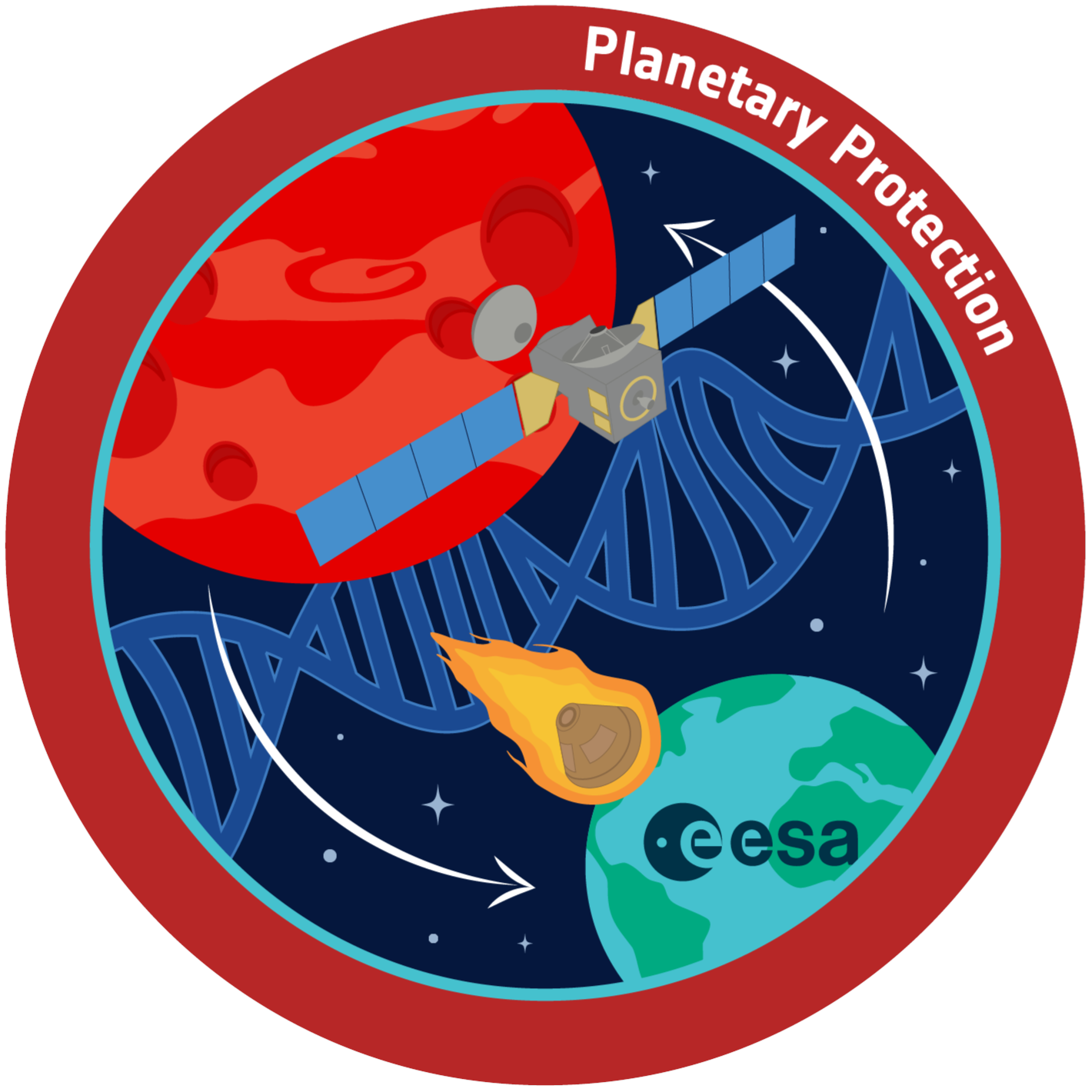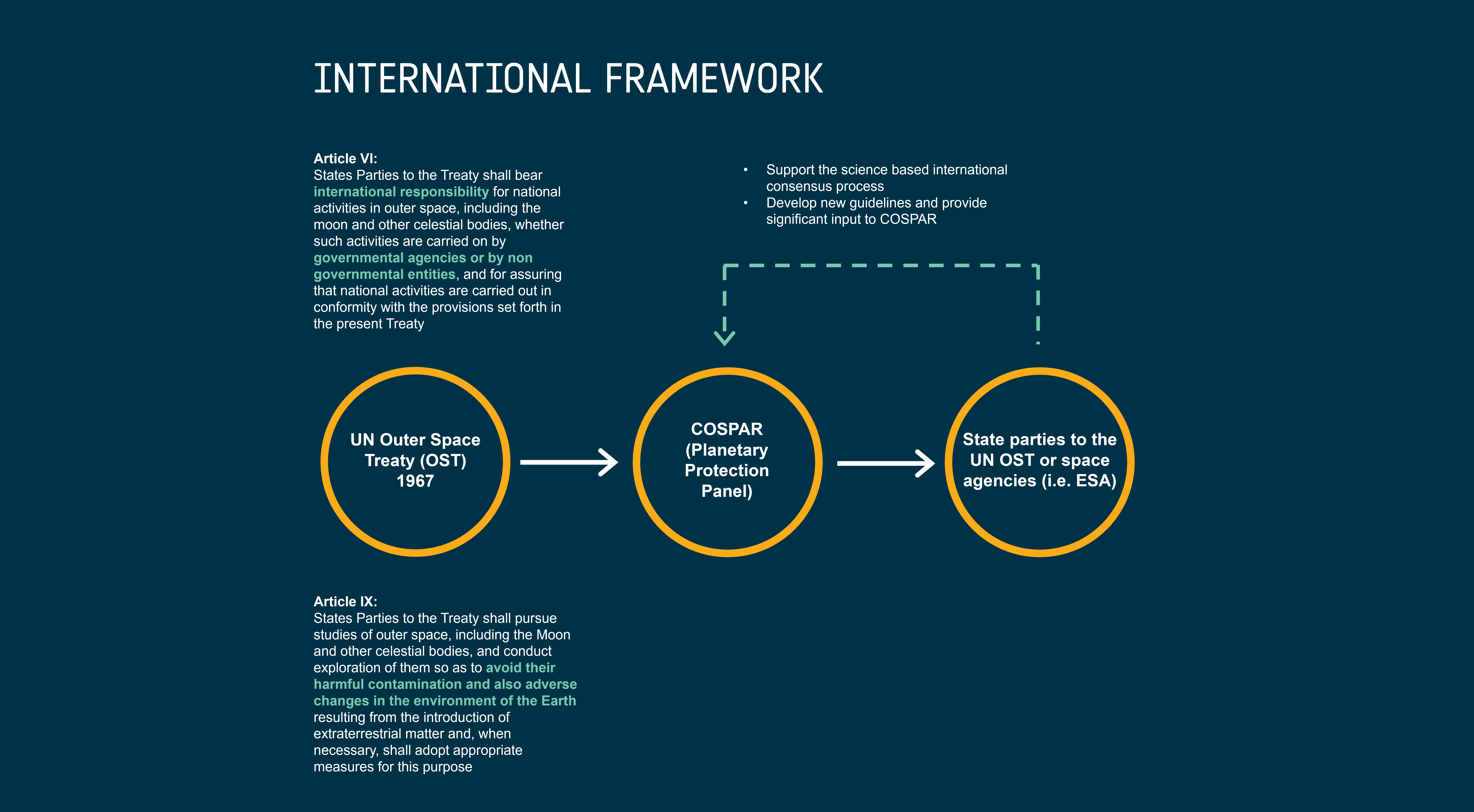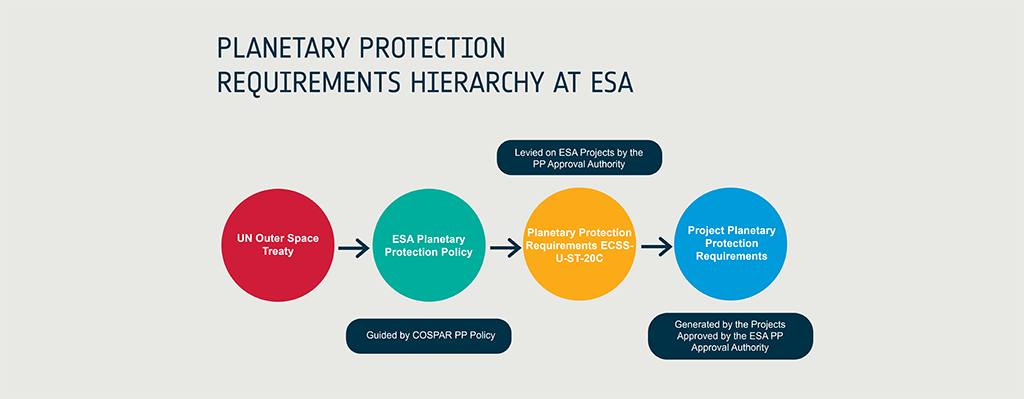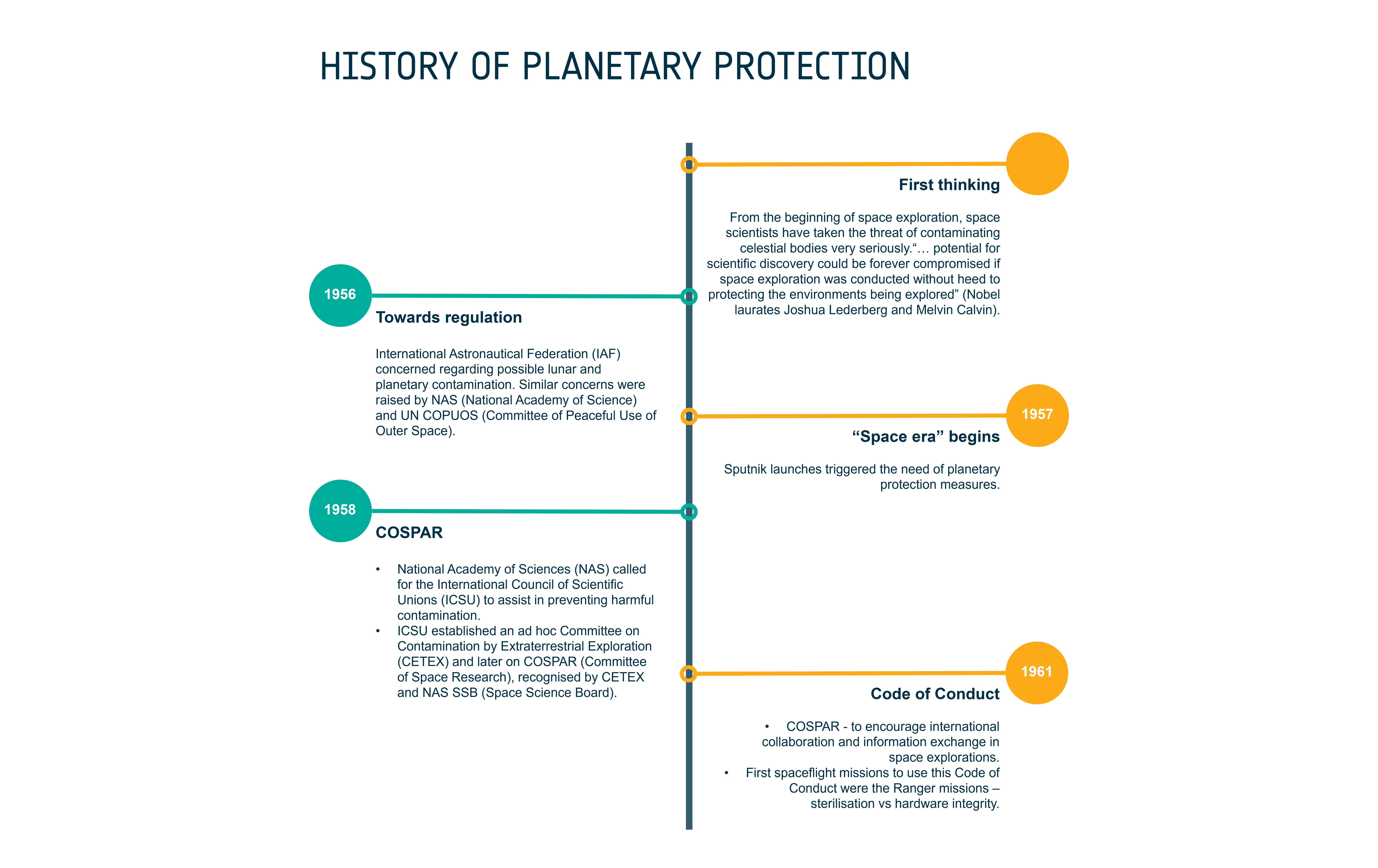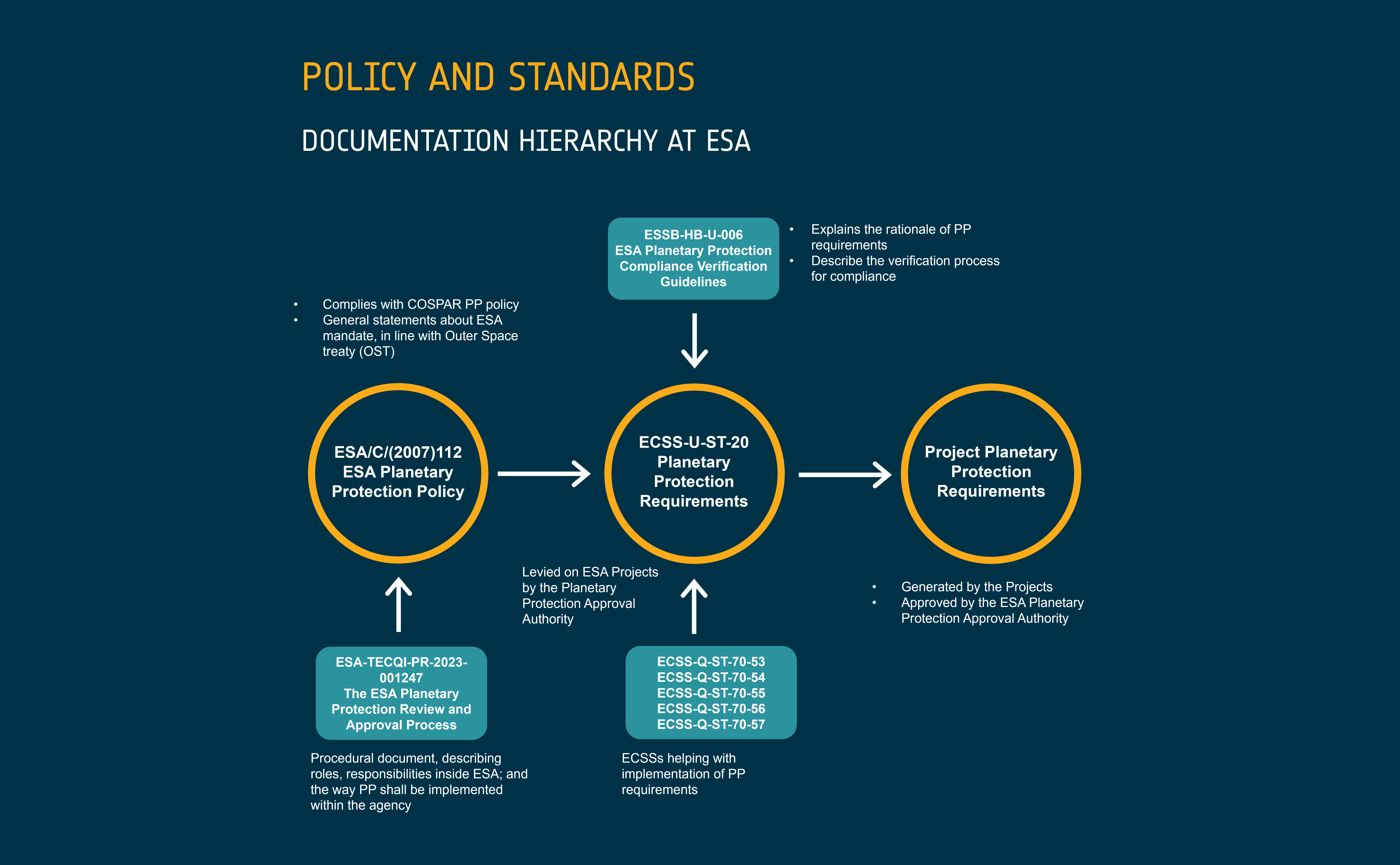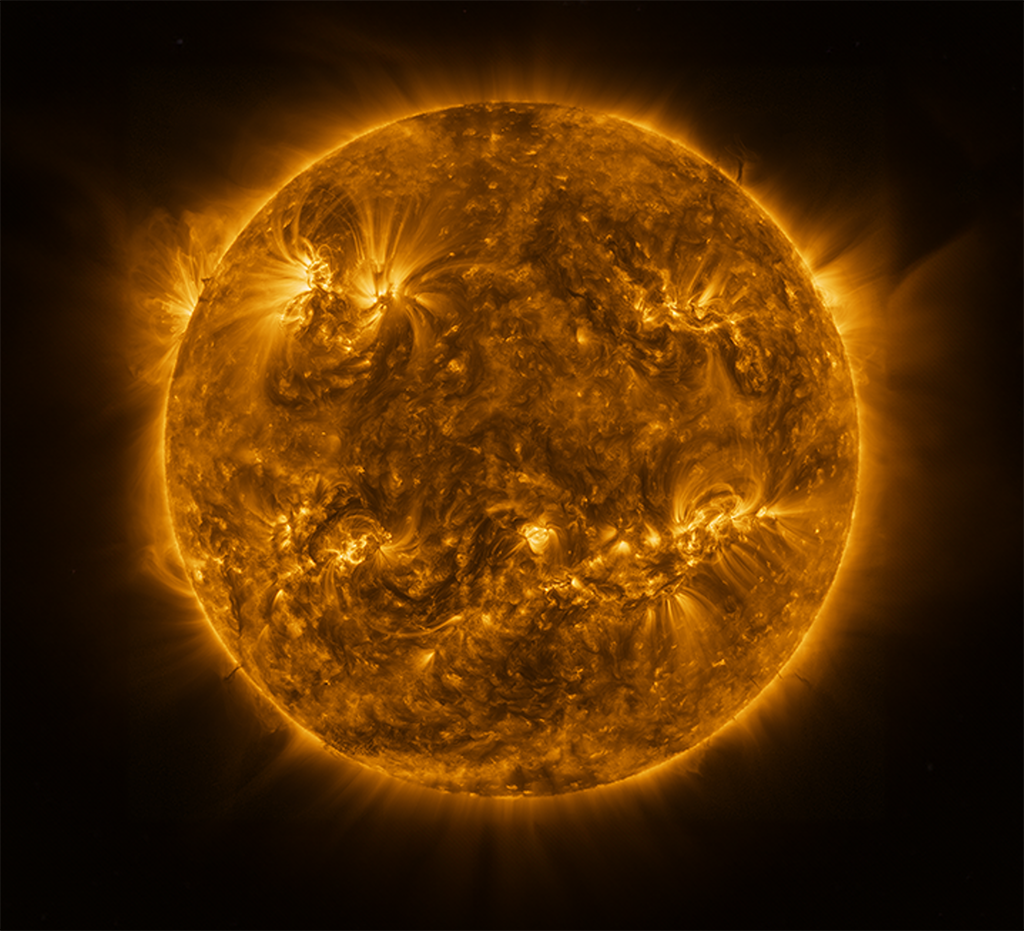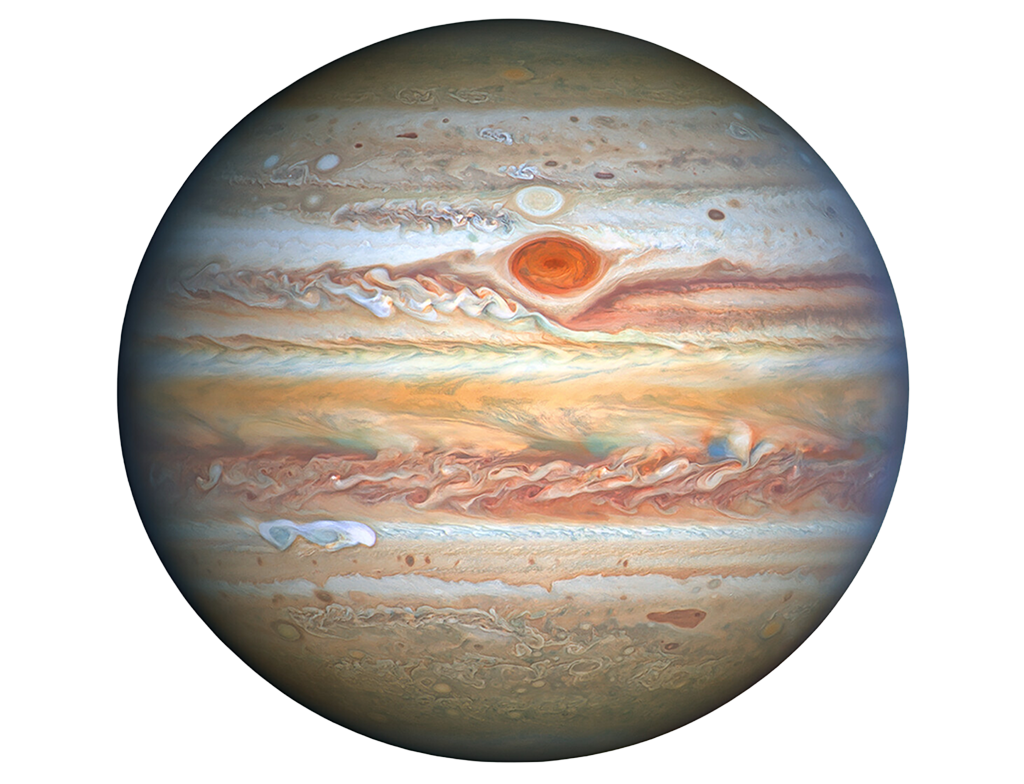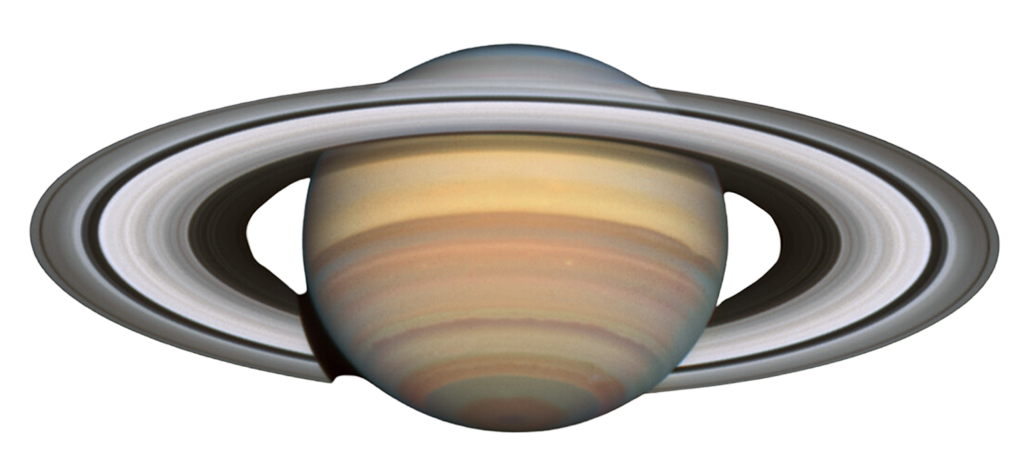Planetary Protection
Planetary protection is the discipline of promoting the sustainable and responsible exploration of space by tackling the potential transfer of biological matter to and from Earth and other objects in the Solar System.
Article IX of the Treaty on Principles Governing the Activities of States in the Exploration and Use of Outer Space, including the Moon and Other Celestial Bodies (the “Outer Space Treaty”), requires that State parties to the treaty conduct the exploration of outer space, including the Moon and other celestial bodies, “so as to avoid their harmful contamination and also adverse changes in the environment of the Earth resulting from the introduction of extra-terrestrial matter and, where necessary, [to] adopt appropriate measures for this purpose”.
ESA acts on behalf of its Member States, all of which are State parties to the Outer Space Treaty. As such, the execution of ESA’s activities shall comply with the Member States’ obligations pursuant to Article IX of the Outer Space Treaty.
ESA planetary protection policy ESA/C/(2007)112, which complies with the COSPAR PP policy and implementing guidelines, is based on two fundamental principles:
Principle 1: The Earth must be protected from the potential hazard posed by extraterrestrial matter carried by a spacecraft returning from an interplanetary mission (backward planetary protection) .
Principle 2: The coduct of scientific investigations of possible extra-terrestrial life forms, precursors, and remnants must not be jeopardised (forward planetary protection).
Planetary Protection Categories
1
Category I
All types of missions (fly by, orbiters, landers) to a target body which is not of direct interest for understanding the process of chemical evvolution or the origin of life. No protection of such bodies is warranted, and no planetary protection requirements are requested by COSPAR policy.
Examples: undifferentiated, metamorphosed asteroids Io; others to be defined (TBD).
2
Category II
All types of missions (fly by, orbiters, landers) to those target bodies where there is significant interest relative to the process of chemical evolution and the origin of life, but where there is only a remote chance that contamination carried by a spacecraft could compromise future investigations. Examples: Venus; Moon; Comets; Carbonaceous Chondrite Asteroids; Jupiter; Saturn; Uranus; Neptune; Ganymede*; Callisto ; Titan*; Triton*; Pluto/ Charon*; Ceres; Kuiper belt objects > ½ the size of Pluto*; Kuiper belt objects < ½ the size of Pluto; others TBD.
*Additional analysis is required. The mission specific assignment of these bodies to Category II must be supported by an analysis of the “remote” potential for contamination (a probability of introducing a single viable terrestrial organism of < 1 x 10-4).
3
Category III
Flyby, orbiter and other missions to a target body of chemical evolution and/or origin of life interest and for which scientific opinion provides a significant 2 chance of contamination which could compromise future investigations.
Examples: Mars; Europa; Enceladus; others TBD.
4
Category IV
Probe and lander to a target body of chemical evolution and/or origin of life interest and for which scientific opinion provides a significant chance of contamination which could compromise future investigations.
Examples: lander Missions: Mars; Europa; Enceladus; others TBD
5
Category V
Any Earth return missions. The concern for these missions is the protection of the terrestrial system, the Earth and the Moon. unrestricted Earth return for solar system bodies deemed by scientific opinion to have no indigenous life forms, and restricted Earth return for all others.
Examples: Any Earth return mission. “Restricted Earth return”: Mars; Europa; others
TBD. “Unrestricted Earth return”: Venus, Moon; others TBD.
“Remote” here implies the absence of environments where terrestrial organisms could survive and replicate, or a very low likelihood of transfer to environments where terrestrial organisms could survive and replicate. “Significant” here implies the presence of environments where terrestrial organisms could survive and replicate, and some likelihood of transfer to those places by a plausible mechanism.
ESA Planetary Protection Advisory Panels
Planetary Protection Advisory Panel
The PP Advisory Panel has the main task to advice the PPO and/or make recommendations on:
- The formulation and updating of the planetary protection policy and requirements;
- The identification and prioritization of standards and procedures for implementing planetary protection requirements;
- The identification and prioritization of mid- and long-term research and technical development needs in the field of planetary protection;
- The planetary protection categorization and pre-launch certification of spaceflight missions;
- Spaceflight missions compliance prior to the segments of the return phase of restricted Earth return missions;
- The risk resulting from the release of unsterilized particles during restricted Earth return missions.
The PP Advisory Panel comes together to work the tasks above as requested by the PPO. The Panel members are ESA internal and/or external subject matter experts of various disciplines from within ESA Member States. The members are appointed by the head of the Product Assurance and Safety Department (TEC-Q), based on recommendation from the PPO.
The Panel might have different compositions (varying members), to make sure the right subject matter experts are allocated in the Panel for the specific task to be worked.
The PPO is the Executive Secretary of the PP Advisory Panel.
The Head of the Independent Safety Office (TEC-QI) is the chair of the PP Advisory Panel.
For restricted Earth return missions, the PP Advisory Panel is called Planetary Protection Re-Entry Safety Panel (PPRSP).
Planetary Protection Re-entry Safety Panel (PPRS) for Mars Sample Return
A planetary protection re-entry safety review is organised in order to comply with the Outer Space Treaty (Principle 1), ESA PP Policy ESA/C(2007)112 and associated ESA corporate duties as a result of potential release of Martian unsterilised material on Earth.
Such safety review will ensure that biological risks are adequately mitigated by the adoptions of measures during all phases of the missions: prior to launch of ERO mission, prior to entering the return phase of the ERO mission, and prior to the release of the Earth Entry System.
The objective of the PP re-entry safety review is to ensure all the biological risks to public safety and Earth’s environment, as a result of potential unsterilised Martian material being in contact with our biosphere, are fully mitigated.
The ESA planetary protection re-entry safety review panel (PP-RSRP) is established as a self-standing entity with the mandate to review and assess all public and Earth environmental safety aspects.
Panel memebrs for first Kick-Off meeting
- 9 international recognised experts coming from public safety, astrobiology, space agencies (DLR,
- CNES, ASI, UKSA) and COSPAR PP Panel;
- Co-chair is an external member, Public Health to give a more independent weight to the review;
- ESA independent members covering a wide range of engineering and mission discipline, including
- RAMS, Operations, Product Assurance, Safety, Materials, etc. to assess planetary protection reentry aspects from all angles (i.e. complementing scientific external representatives).
Missions
Solar System Bodies
Venus
Moon
Mars
Jupiter
Documents
COSPAR
ECSS
Outer Space Treaty
Frequently asked questions
1
Can you give examples of what planetary protection entails, specifically for missions to Mars?
In practice, for missions to target bodies, like Mars, of great interest for understanding chemical evolution and/ or origin of life in our solar systems; and for which scientific opinion believes that there is significant chance of contamination which could compromise future investigations, planetary protection sets limits for the level of acceptable microbiological contamination and for the probability of impact of spacecraft.
Mars is a primary target in the search for evidence of extraterrestrial life, past or present, and for this reason planetary protection requirements are very much Mars-centric. To satisfy these requirements, for orbiters or for spacecraft performing flybys, mission teams must demonstrate one of two things. Either that there is a very small chance of the spacecraft crashing or impacting on its target world or that, in the event of a crash, the chance of biologically contaminating the planet is below a set limit.
For the ExoMars Trace Gas Orbiter for example, ESA has chosen to satisfy the impact probability constraint. The Agency has demonstrated that there is a less than 1 in 100 chance of an impact on the planet for the first 20 years after launch and less than 5 in 100 chances for the time period from 20 to 50 years after launch.
These assessments are made by scrutinising the design, evaluating the operational reliability of the mission, the flight hardware reliability, the effects of the natural space environment such as micrometeoroids and Mars atmospheric variations. The launcher upper stage is also subject to impact probability requirements, even more restrictive, to ensure that it does not impact Mars after separation from the spacecraft. For a lander or a rover set to land on the Red Planet, the limits on the level of possible microbiological contamination are very stringent. The ExoMars Rosalind Franklin rover has been built in a biologically controlled cleanroom, with strict operational procedures and personnel trained regularly.
People are the biggest source of contamination for flight hardware. A dedicated training programme for all personnel involved in the construction and testing of the ExoMars Rover, and the development of new cleanroom operating procedures were implemented.
All of the flight hardware went through numerous cleaning cycles with sterile 70% isopropyl alcohol and/ or exposed to different levels of sterilisation, like dry heat microbial reduction, which is achieved by exposing equipments to temperatures above 110°C for a time that can vary from several hours to several days. Tens of thousands of microbiological assays were carried out throughout the assembly, test and launch operations to check that these procedures were working well.
The planetary protection requirements have been verified by internal and independent assessments throughout the project lifecycle during reviews, audits and tests. The final certificate of compliance is issued based on these results and for the launch readiness review.
2
What are the ESA missions affected by Planetary Protection?
Any mission leaving Earth’s orbit is affected by planetary protection requirements. Each mission is assigned a category depending on a combination of target body (whether this is of interest to understand chemical evolution and origin of life in our solar system) and the type of mission (i.e. orbiter, fly-bys, landers), according to the COSPAR guidelines. And for each case, control measures prevent harmful contamination to celestial bodies and protect Earth from potential hazards from other worlds.
3
What is COSPAR?
The primary objective of the COSPAR Planetary Protection Panel (PPP) is to maintain, develop the COSPAR Policy and its associated requirements for the reference of spacefaring nations and to provide guidance upon request with compliance with the Outer Space Treaty. The COSPAR PP policy is a classic example of ‘soft law’ and rely on stakeholders to adhere to it.
The COSPAR PPP ensures that the COSPAR Policy and its associated requirements are up-to-date and represent the actual needs for space exploration. Its structure comprises a total of 25 members: these are formally appointed scientists/experts and representatives from space agencies.
The Terms of Reference ensure a balance between space agency representatives and scientists. COSPAR PP policy defines five categories for target body or mission type (orbiter, lander) combinations. For each category there are respective recommended requirements.
4
How does ESA interact with your international partners?
The short answer is in an open and collaborative manner. Planetary protection really benefits from international consensus. Requirements are not cast in stones, and new discoveries on target bodies could trigger re-evaluation of needs and implementation measures. In this kind of environment, international cooperation is essential to tackle never faced before problems and analyse planetary protection from different angles. Private and commercial entities for example are playing an always more important role. Communication with them as a key factor for success in planetary protection.
5
What are the next big challenges for Planetary Protection?
The ESA Agenda 2025 and Terrae Novae vision articulate ambitious space exploration plans for the next three years and beyond, aiming to increase European autonomy and leadership in space. These plans include the search for extraterrestrial life, returning samples from Mars, the unprecedented desire for a stable European presence on the Moon’s surface and crewed missions to Mars (Terrae Novae 2030+ Strategy Roadmap, June 2022).
The complexity of such missions calls for a rethink of current Planetary Protection approaches, including the expansion of tools and methods used to measure biological contamination. Research and technology developments in the field of molecular biology are considered paramount for planetary protection. These techniques provide key information to assess contamination risks, in the effort to ensure that target bodies are kept as pristine as possible during astrobiological exploration (forward contamination), and to control and safeguard crew health, general public, and Earth’s biosphere (backward contamination).
One of the major areas of research is currently going towards the development of probabilistic models and the use of artificial intelligence to circumnavigate some of the current unknown in the field. Real biological test data, gathered from cleanrooms and flight hardware, will then feed any used model to make it robust and credible. There is a big push to investigate innovative and more flexible biological assay methodologies that can be tailored for space planetary missions and that can measure a broader range of microbes, in a timely manner and with reduced costs.
A shift at ESA from a prescriptive to a risk-assessment based approach, would require direct involvement of international partners and stakeholders, multidisciplinary approaches, and larger community consensus. Leadership from COSPAR planetary protection panel is considered key at ESA to succeed and reach international consensus, where European academia, institutions will be active part of the journey.
Training and Workshops
19-22 November, 2024
NASA Ames in Mountain View,
California, USA and Online
Metagenomics in Spaceflight: Establishing an Implementation Roadmap
17-19 October 2024,
Fraunhofer IPA, Stuttgart, Germany
Introduction to Planetary Protection
3-4 October, 2023
ESA-ESTEC, Noordwijk, The Netherlands
Planetary Protection Requirements For Future Exploration Missions: Assessing Metagenomic Methods For their Inclusion In ESA Standards



